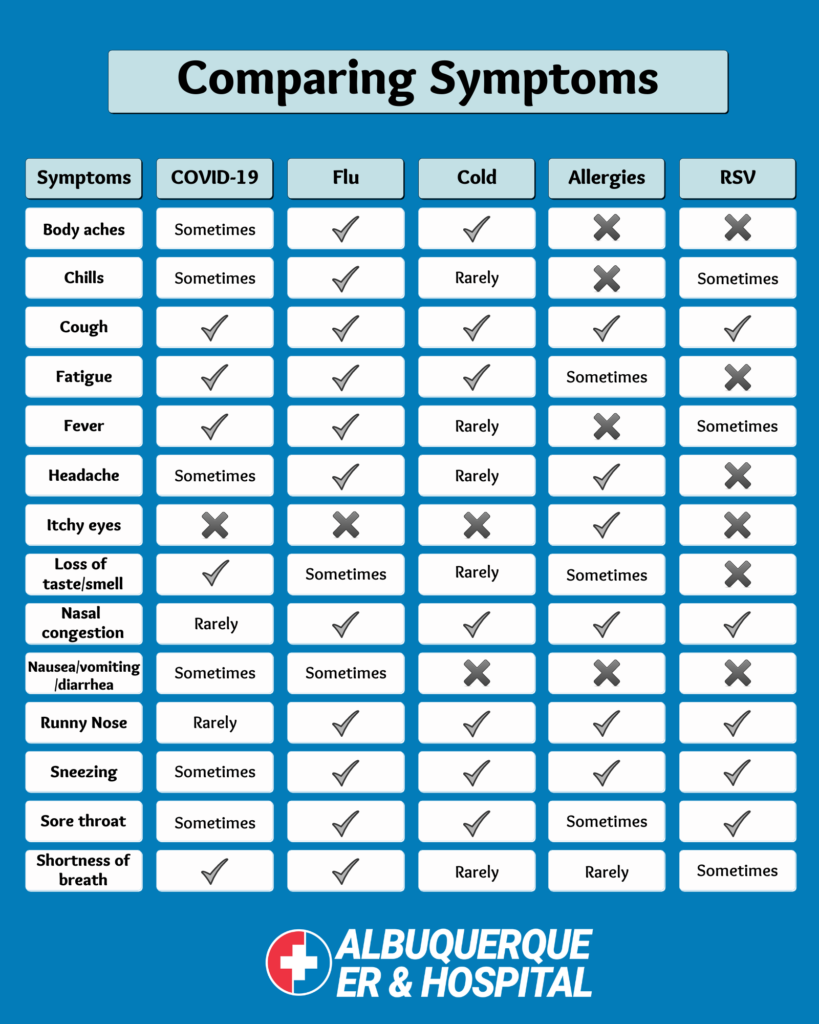The Difference between COVID-19, the Flu, Allergies, RSV, and a Cold
We’ve all been there; you wake up with a sore throat and your brain immediately starts rattling off the possible sicknesses you’ve caught. With cold and flu season colliding with COVID-19 spikes, it’s hard to tell what you’ve come down with. Cue the frantic Googling!
To help settle some of the confusion, we’ve provided a visual representation to review the commonalities and differences between widespread illnesses that share many of the same symptoms. Let’s get into it!
General COVID-19 Rundown
COVID-19, the virus that’s been on the top of everyone’s mind the last two years. Although it will take time for scientists and doctors to better understand this virus, there have been consistent factors at play over the course of this pandemic.
Here are five things we know about COVID-19:
- COVID-19 is an infectious disease caused by the SARS-CoV-2 coronavirus.
- Viruses are constantly changing. Their genetic code mutates, affecting how the virus looks or impacts its host. This mutation creates a variant of the virus strain.
- Known variants of SARS-CoV-2 include Alpha, Beta, Delta, and the variant currently circulating the US, Omicron.
- The most common symptoms of COVID-19 include cough, shortness of breath, fatigue, fever, and loss of taste or smell. Some people experience nausea, vomiting, diarrhea, and body aches as well.
- With this new omicron variant, it’s reported that many patients are not losing their taste or smell but are still experiencing the other symptoms listed.
- Washing your hands, wearing a mask, and keeping your distance from others can help lower your risk of infection.
- Getting vaccinated can lower the severity of your symptoms and reduce your risk of spreading the virus.
- Medical experts report those who are fully vaccinated are experiencing much more mild symptoms compared to those who are unvaccinated.
Comparing Symptoms
We’ve listed a general rule of thumb for similarities and differences between COVID-19, the flu, a cold, allergies, and RSV.

Symptoms of these common illnesses can overlap, and just because you have something on the list, doesn’t mean that’s your diagnosis. Per the CDC, “Because some of the symptoms of flu, COVID-19, and other respiratory illnesses are similar, the difference between them cannot be made based on symptoms alone. Testing is needed to tell what the illness is and to confirm a diagnosis.”
Please refer to the COVID-19 testing information linked above. As always, we are here for all your emergent needs, but we are not a designated testing site. Rapid tests are in short supply and availability is not guaranteed.
Flu vs COVID-19
According to the CDC, COVID-19 seems to spread more easily than the flu. And compared to the flu, COVID-19 can take longer to show symptoms, be contagious for longer, and cause more serious illnesses in some people. Typically, people experience symptoms anywhere from one to four days after being infected with the influenza virus. COVID-19 can take anywhere from two to 14 days to show symptoms.
Flu season occurs in the fall and winter, with February being the peak month.
Cold vs. COVID-19
The common cold, the flu, and COVID-19 are all contagious respiratory illnesses caused by different viruses. Colds are usually caused by rhinoviruses, while COVID-19 is caused by SARS-CoV-2 coronavirus, and the flu is caused by the influenza virus. Although the viruses spread in similar ways and cause many of the same symptoms, there are defining differences as seen in the chart above.
Cold symptoms usually appear within one to three days of exposure, compared to the COVID-19 two-to-14-day window.
Allergies vs. COVID-19
Although seasonal and environmental allergies are not caused by a virus, they have similar effects on the body. With comparable symptoms like a runny nose, sore throat, and cough, it’s common to mistake allergies with a cold or the coronavirus. The major differences between allergies and respiratory illnesses are that allergies are not contagious and can last months or be present year-round.
RSV vs. COVID-19
Respiratory Syncytial Virus (RSV) is a common respiratory virus that can cause cold-like symptoms in children and adults. Although the virus is usually mild, it can cause complications like bronchiolitis, inflammation of the lung’s airways, and pneumonia, an infection in the lungs. Infants and the elderly are more at risk for developing severe symptoms.
RSV cases increase during flu and cold season, and unlike COVID-19 and the flu, there is not a vaccine for RSV. You can lessen your risk during the fall and winter months by frequently washing your hands, washing toys regularly, keeping kitchens, countertops, and bathrooms clean, and not sharing food or drinks with others.
We’re Here to Help
If you’re experiencing persisting or severe symptoms of any kind, contact your doctor for proper testing and treatment.
We understand that this is an uneasy time, and with flu season in full swing, we’re here to lend a helping hand. For all your medical emergency needs, we are here to assist you 24/7, 365 days a year.
